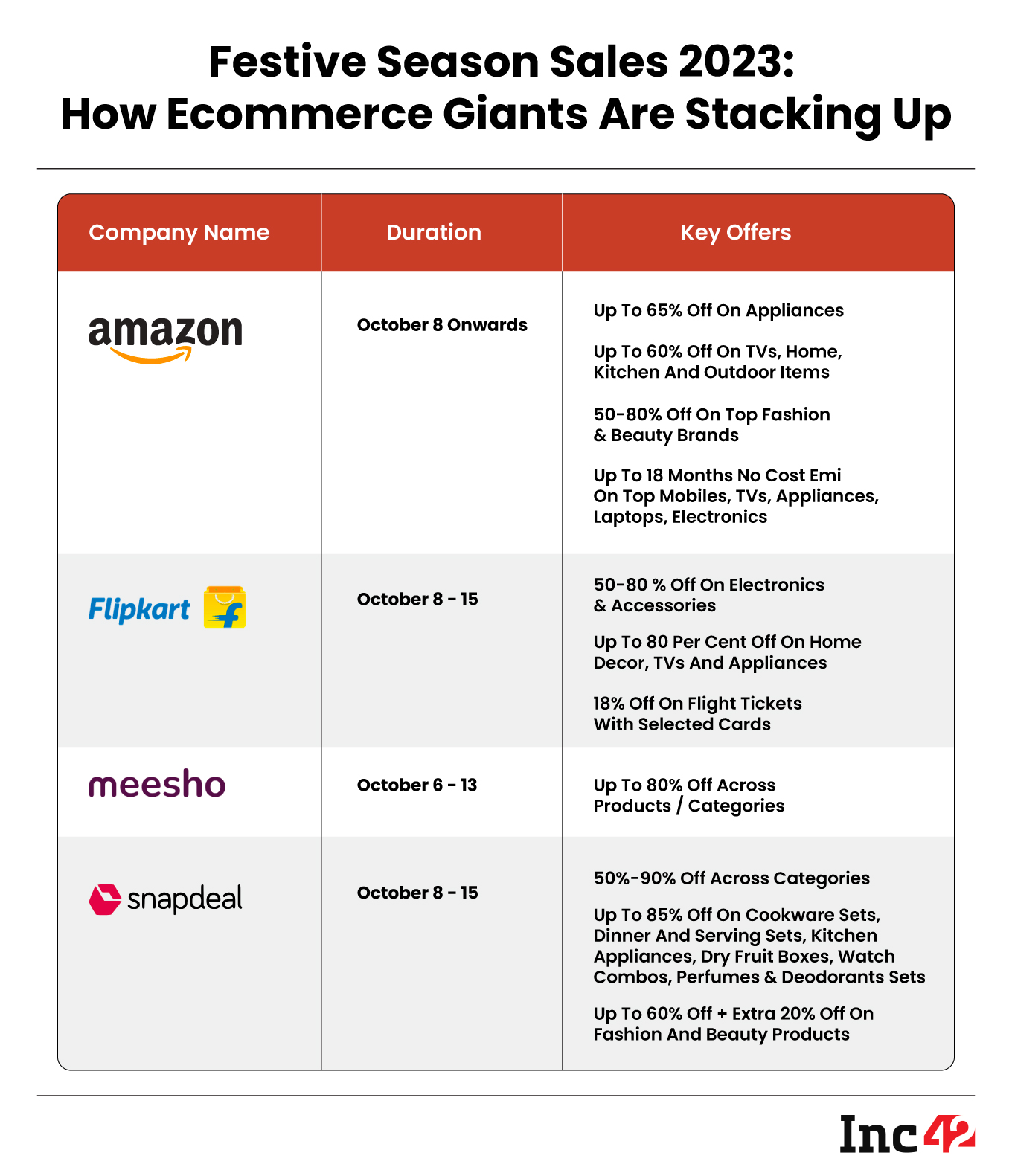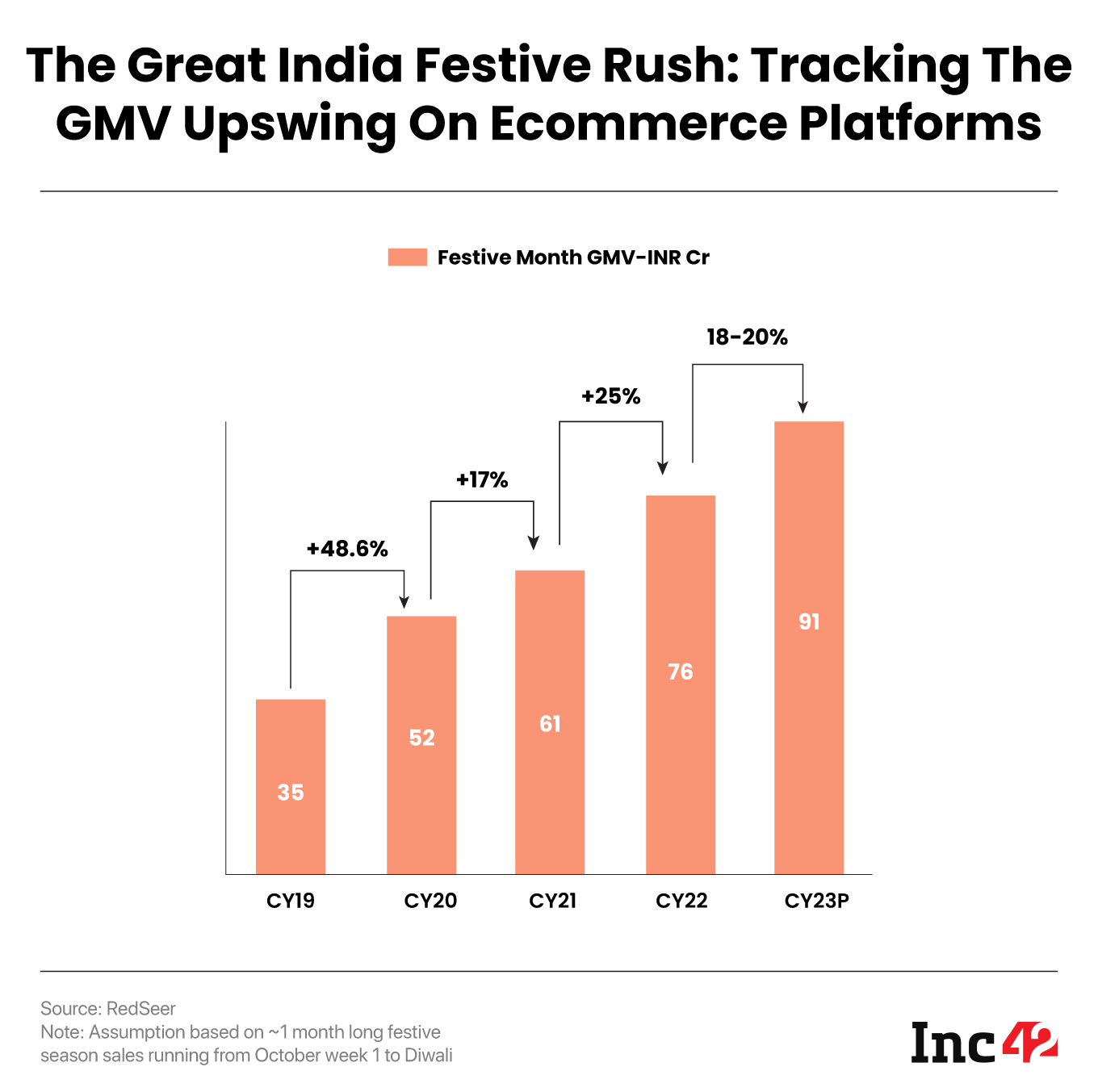10th Year Of Festive Season Sales: 5 Trends That Will Define Clash Of Amazon, Flipkart, Meesho & Cos This Year

As the festive season rings in its 10th anniversary in the ecommerce realm, giants like Flipkart and Amazon are prepping for their annual mega sales, set to begin on October 8. This year, however, they will face tough competition from newer players, including Meesho, which carved out a significant slice of the festive sales pie last year.
With new entrants like Tata Neu and JioMart, and fashion and lifestyle ecommerce players such as Myntra, Nykaa, and AJIO, the stage seems to be set for a fierce showdown.
For these ecommerce platforms, the annual festive sales aren’t merely about revenue generation; they’re pivotal customer engagement and acquisition opportunities. These events lure consumers with compelling discounts and promotions, giving a considerable boost to their yearly sales targets.
Through strategic marketing blitzes, they also aim to amplify brand recognition and glean insights into shopper preferences. Following last year’s subdued festivities, market analysts have predicted a revival in shoppers’ enthusiasm this year, forecasting a robust 20% surge in sales.
The festive season this year is set to witness a remarkable upswing in the ecommerce sector’s gross merchandise value (GMV). According to consulting firm Redseer, the GMV is anticipated to see an 18-20% surge, amounting to INR 90,000 Cr, a leap from INR 76,000 Cr in the previous year.
“The preceding quarter (April to June) witnessed a subdued performance in both offline and online retail sectors, primarily due to persistent inflationary pressures. However, the scenario is expected to undergo a transformation during the upcoming festive season. Festive periods tend to unleash latent consumer demand, prompting individuals to open their wallets more liberally,” Ashish Dhir, EVP (consumer and retail) of business consulting and services firm 1Lattice said.
There is a growing focus on electronics and appliances as traditional categories of interest. However, fashion and beauty are also emerging as important categories. The emergence of luxury goods is another important segment, which will likely make waves during the upcoming festive sales.
The ecommerce industry anticipates a stronger festive season compared to last year with over 20% sales growth, driven by the D2C segment’s expected 40% quarter-over-quarter (Q0Q) surge. However, average user spending is likely to remain flat.
Further, Tier III cities and beyond are becoming key revenue contributors, particularly in the fashion and beauty categories. Although consumer sentiment has improved, retailers are wary that buyers could maintain a cautious stance when it comes to spending lavishly.
While there is much to look forward to, let’s delve deeper into what shoppers and retailers can expect from this milestone year, which marks 10 years of festive sales fervour in the Indian ecommerce space.
D2C Brands To Lead The Charge
Notably, the Indian market is projected to have 500 Mn+ online shoppers by 2030, growing at 12% compound annual growth rate from 205 Mn in 2022, according to a 2020 report.
As far as the upcoming quarter is concerned, industry experts forecast that the homegrown ecommerce sector will likely see impressive growth of over 20%.
Playing a pivotal role in this escalation will be the D2C segment, predicted to grow more than 40% QoQ from October to December. Established ecommerce giants like Amazon, Flipkart and Meesho could also be looking at an approximate 30% uptick in sales, according to experts.
Tracing back to the inaugural ecommerce festive sales in 2014, the industry’s GMV was recorded at INR 27,000 Cr. Fast forward to 2023, the GMV is poised to touch an impressive INR 5,25,000 Cr, a nearly 20-fold increase, per a RedSeer report.
 Average User Spending Could Remain Muted
Average User Spending Could Remain Muted
Despite the rise in GMV in 2022 compared to 2021, average expenditure per shopper held steady at INR 5,200 during the initial four days of the festive season sale, according to a RedSeer report.
This year doesn’t seem poised for a significant spike in individual user spending either. However, there is a silver lining in the form of rising consumer activity in smaller towns and cities. On the flip side, elevated living costs in metropolises like Bengaluru and Mumbai could dent extravagant consumer spending, noted Devangshu Dutta, the founder and CEO of Third Eyesight, a boutique management consulting firm.
Yet, with the growing online shopper populace in these cities, there’s potential for the average order value (AoV) to reduce as more users flock online to shop.
“As the online shopping base continues to expand, the average spending per user naturally tends to decrease. This phenomenon occurs as more people venture into ecommerce, with platforms like Amazon and Flipkart extending their reach to cover a broader audience. However, it’s essential to note that this drop in the average ticket size is a common trend when the customer base expands,” Sangeeta Verma, director of digiCart India said.
Consumers Sentiment Positive, But Retailers Remain Realistic
With the waning impact of inflation, India is witnessing a positive shift in consumer sentiment from the previous year. Unlike several developed nations wrestling with inflation, India has remained largely untouched by its dual impact on demand and supply, experts suggest.
For example, Flipkart delivered strong gross merchandise value (GMV) and sales growth in the company’s second quarter of the financial year 2023-24 (FY24), Walmart’s chief financial officer John David Rainey said during an earnings call.
“In India, the distinguishing factor in terms of festive demand is that it’s not merely brand-driven; consumers here are eager to spend, and the purchase intent is notably high. Unlike some developed economies grappling with inflationary concerns, both the demand and supply sides in India have not seen any impact of inflation. The consumer demand continues to stay buoyant,” Chirag Tanjeja, cofounder and CEO of GoKwik said.
The overlap of festive celebrations and wedding seasons, particularly with a later Diwali this year, is predicted to further stimulate demand, 1Lattice’s Dhir added.
Nevertheless, a note of caution reverberates among retailers. Despite the evident purchase intent, retailers are preparing for a possibly neutral festive season as economic challenges may hit consumers’ spending.
However, a recent study conducted by Nielsen Media India and commissioned by Amazon India says otherwise. According to the report, 81% of consumers are enthusiastic about shopping during the upcoming festive season. More importantly, this positive sentiment towards online shopping is not limited to metropolitan areas but Tier II and III cities and towns.
Ecommerce Platforms Ramp Up Efforts To Woo Sellers
In this year’s festive season, a standout trend is ecommerce giants’ intensified drive to court and captivate sellers with multiple strategic offerings like enticing commission rates, equipping them with advanced selling tools, enhancing the overall selling experience, and broadening their outreach.
Recently, ecommerce heavyweight Meesho made its platform accessible to non-GST registered sellers too. Not too behind in the race is Amazon India, which unveiled its multi-channel fulfilment (MCF) last month for D2C brands and retailers. This initiative is expected to aid sellers in managing customer orders from diverse channels.
Meanwhile, Flipkart flaunted its impressive seller growth, citing a tally surpassing 1.4 Mn — a notable 27% jump since 2022. Meesho currently has a seller base of 1.3 Mn and Amazon has over 1.2 Mn sellers.
Echoing the seller-side optimism, digiCart’s Verma said, “As a seller, we hold a very bullish sentiment. We’re so confident that we started stocking up well in advance. The robust build-up is evident from the current numbers. Mature sellers will expand into existing and new categories after.”
A recent survey by Redseer revealed that sellers are projecting a 15% increase in festive sales year-on-year. Even though the recent sales momentum on ecommerce platforms has been somewhat subdued — with only 40% of those surveyed reporting a 10% quarterly hike — there’s palpable enthusiasm for a significant festive sales boost across a multitude of product sectors.
Who Will Drive The Festive Ecommerce Growth?
Tier II and III cities and towns are expected to be the biggest contributors in this year’s festive season sales. According to experts, customers from these cities and towns are keen on giving their wardrobes and beauty kits a festive makeover. Although Tier I cities are spoilt for choice with numerous offline stores, spanning both legacy and contemporary brands, such luxuries are scarce in smaller cities.
However, this is steadily changing now. Some of the prominent D2C brands that have emerged from the country’s Tier II & III towns and cities are Raipur-based Drools, Mohali-based Lahori, Kanpur-based Phool, Coimbatore-based Juicy Chemistry, just to name a few.
Furthermore, consumer demand in the eastern regions of the country, along with enhanced connectivity in the Northeast, is also on the rise. Semi-urban and rural areas are fast emerging as the driving force behind the new wave of ecommerce growth, a trend expected to be pronounced during the festive season.
Considering that a whopping 65% of India’s populace resides in rural regions, the untapped ecommerce potential is immense, according to the Economic Survey 2022-23.
Yet, fostering trust will be paramount. Residents in these regions typically bank on word-of-mouth endorsements and recommendations from local retailers when exploring new products and brands. This is expected to give local D2C brands a much-needed boost in the upcoming festive season.
What’s Beyond The Festive Sale Fervour
As festive trends leave their mark in the ecommerce landscape, we’re likely to witness several transformative strategies. Central to this evolution will be Buy Now, Pay Later (BNPL) schemes. Yet, the traditional cash-on-delivery remains a preferred choice for many.
Ecommerce brands are increasingly prioritising customer retention, recognising that fostering enduring relationships offers more value. This shift is evident in the rise of loyalty programmes.
Notably, Flipkart introduced “Flipkart VIP” – a direct competitor to Amazon’s Prime – right before the festive sales kickoff. Simultaneously, Meesho debuted a loyalty initiative, targeting both customers and sellers.
Apart from the dominant themes, a few other noteworthy trends are slated to redefine the festive shopping narrative. Black Friday, for instance, is set for a revamp. Gen Z’s influence, especially their propensity to favour specific brands, will be significant.
Last year, for D2C brands, the Black Friday event overshadowed the traditional Diwali and Dusshera festivals in sales figures. GoKwik data indicates that brands on their platform saw a staggering 63% rise in GMV during the Black Friday sale, contrasting starkly with the 10-day Diwali sales.
Also, Christmas, too, is evolving. The allure of winter holidays and modern gifting practices are propelling this transformation, turning Christmas into a significant commercial event.
Given that the final leg of 2023 (October to December) will host almost all the major Indian festivals, the ecommerce players are in for a treat. Even though there will be a lot of cut-throat competition among ecommerce players, there will be no dearth of opportunities for them to woo customers who are eager to splurge to add more flavours to their festive celebrations this year. Going ahead, we will keep a close eye on the ecommerce players and D2C brands that will emerge triumphant after the great Indian festive showdown.
The post 10th Year Of Festive Season Sales: 5 Trends That Will Define Clash Of Amazon, Flipkart, Meesho & Cos This Year appeared first on Inc42 Media.

No comments